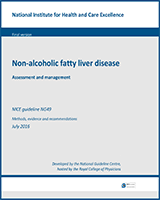| Relative values of different outcomes | The GDG agreed that progression of NAFLD was the only relevant outcome for this review, as assessed by a variety of methods, that is, liver biopsy (including NAS), MRI or MRS, ultrasound (reporting absence of steatosis only), ELF, transient elastography or NAFLD fibrosis score. |
| Trade-off between clinical benefits and harms | The GDG also discussed the evidence from prospective cohort studies that suggested that the co-existence of obesity and moderate alcohol intake had a super-additive effect on the rates of liver disease incidence, as well as liver-related mortality.
The prospective longitudinal study that was included in this review provided evidence that heavy episodic drinking at least once per month (‘binge drinking’) is a strong risk factor for fibrosis progression in adults with NAFLD. Although the GDG felt that the evidence had limitations (see ‘quality of evidence’ below), they concluded that light to moderate alcohol intake (up to 280g ethanol per week) was not associated with increased rates of NAFLD.
The GDG considered the evidence that appeared to demonstrate a decreased rate of development of NAFLD in men drinking up to 280g of ethanol per week, but no effect of such levels of consumption on NAFLD rates in women. However, based on the identified evidence, the GDG concluded that whilst alcohol consumption within UK recommended levels appears to be safe in people with NAFLD, the limitations of the evidence meant that they were not able to conclude that alcohol intake beyond current UK limits could be deemed safe or recommendable for people with NAFLD. Given the modest amount of evidence that was identified to inform this review question and its clear major clinical importance, the GDG concluded that a research recommendation was justified for studies to investigate whether people with NAFLD should restrict their alcohol intake to below national recommended levels. |
| Trade-off between net clinical effects and costs | No relevant economic evaluations were identified.
The cost of alcoholic drinks falls upon people with NAFLD as consumers. The recommendation in this review would either not affect the quantity of alcoholic drinks consumed or may require advising individuals to reduce their consumption, which would have the additional economic benefit of saving them money. |
| Quality of evidence | The GDG noted that there was high quality evidence reporting a long follow-up of participants (13.8 ± 1.2 years) and careful evaluation of alcohol intake with multivariate analysis adjusting for key confounders. The GDG noted, however, that in their experience, it is unusual for people to begin heavy episodic drinking after the diagnosis of NAFLD and it may indicate that the study participants' original level of alcohol consumption may have been self-reported lower than the true values. Whilst the GDG noted the very large number of participants and long length of follow-up within a large retrospective cohort study, they expressed several concerns regarding risk of bias due to the study design; for instance, the GDG noted that NAFLD had been diagnosed via ultrasound only and that people with heavy alcohol intake were included (who may have had alcohol-related liver disease). In light of this concern, data for participants with heavy alcohol intake were not included within this review. The GDG were also concerned about the indirectness of the prognostic factor measured in the study, which used local recommended alcohol limits in analysing the data that were dissimilar to those in the UK. The GDG were also concerned regarding the analysis of the data and whether it took into account both those who had progressed from baseline and those that had regressed, and noted that this was not clearly reported within the study. The evidence was therefore rated as very low quality due to these risks of bias and indirectness. |
| Other considerations | The GDG were aware of existing evidence (univariate in design) that has shown a correlation between moderate alcohol intake and fibrosis regression in NAFLD cohorts. In addition, they noted data from the cardiovascular literature consistent with moderate alcohol intake being protective against cardiovascular events, a major cause of morbidity and mortality in people with NAFLD. However, they recognised that this evidence could not be used to formulate recommendations for this review question, as the analysis in these studies does not account for key variables that may also influence changes in fibrosis.
The GDG discussed that although no specific recommendation on alcohol intake in teenagers with NAFLD could be made, they agreed that teenagers with NAFLD should be given pragmatic advice about alcohol intake and advised of the risks of regular excess alcohol consumption and heavy intermittent drinking, both for their NAFLD and for their health more broadly, recognising UK alcohol licensing laws.
Research recommendation
The GDG made a research recommendation to investigate if people with NAFLD should restrict their consumption of alcohol to below national limits. See Appendix Q for further details. |
